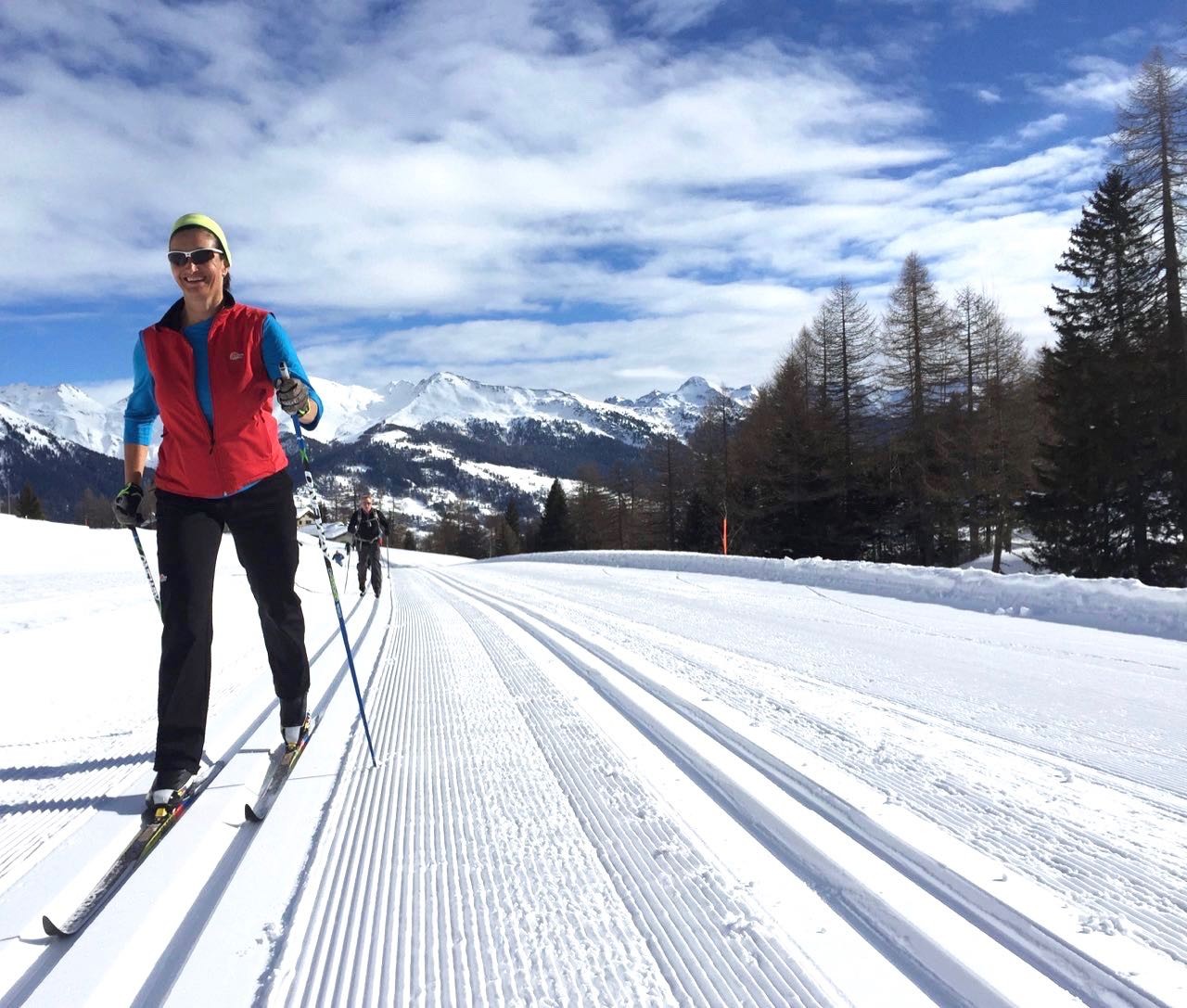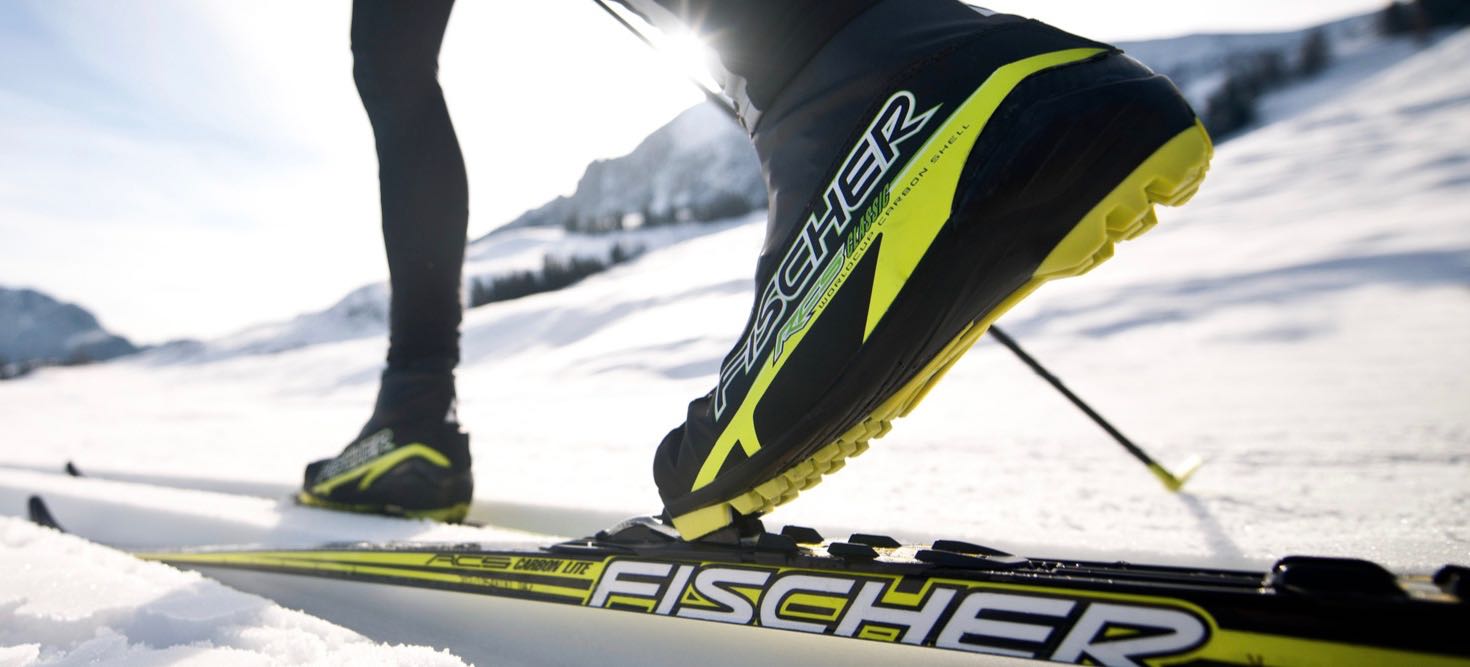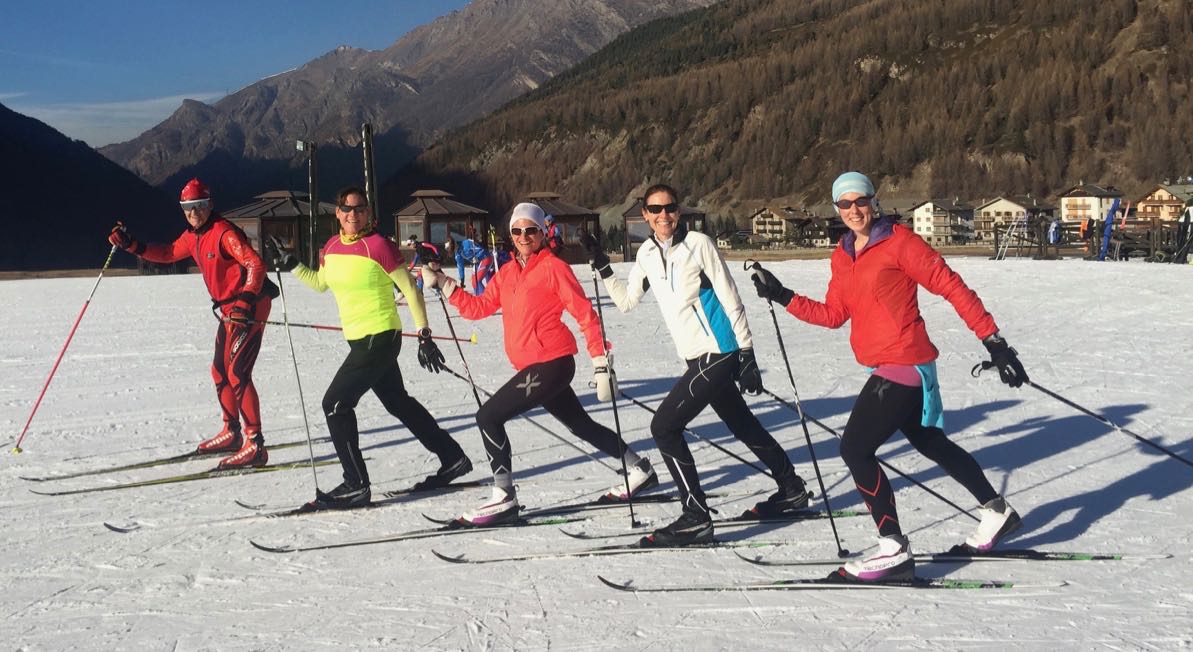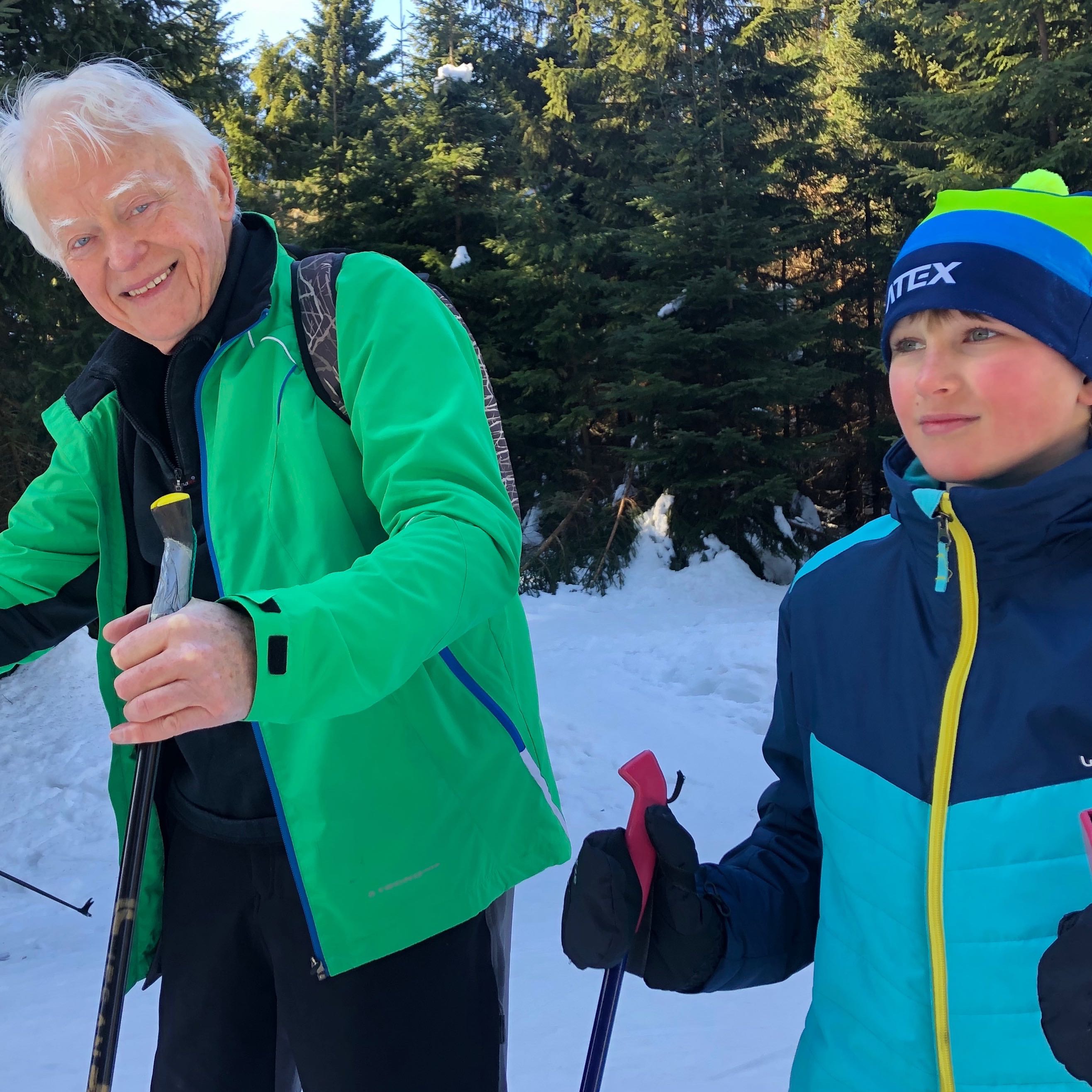 Perfect snow conditions for cross-country skiing. The ski tracks are 'pressed' each day by grooming machines creating a smooth surface.
Perfect snow conditions for cross-country skiing. The ski tracks are 'pressed' each day by grooming machines creating a smooth surface.
Describing this wonderful winter sport to the uninitiated is a challenge, not because it is difficult to learn or indeed to describe, but because it can be hard to get to grips with the many different types of skis and ski techniques. The terminology and language is a challenge in itself. “Am I actually booking the correct type of ski course?” is a common question.
At Tracks and Trails we specialise in ‘cross-country skiing'. This article will attempt to clarify a few points, and answer some frequently asked questions.
The clue is in the name. ‘Cross-country’ skiing is essentially travelling across the countryside on skis. Unlike ‘alpine’ or ‘downhill’ skiing it does not use ski lifts or other infrastructure to climb hills, instead it relies on skiers using technique and ability.
According to Wikipedia cross-country skiing is a "form of skiing where skiers rely on their own locomotion to move across snow-covered terrain".
Think of a walking or running motion with skinny lightweight skis on your feet. The difference is that the skis give you a longer stride than you would gain from running or walking as they allow you to ‘glide’ across the ground.
People from the United Kingdom often refer to this type of skiing as ‘cross-country’, but it is also known as ‘Nordic’ as it hails from Scandinavia. Other names are ‘ski de fond’ in France, ‘sci di fondo’ in Italy, ‘langlauf’ in Germany, and ‘langrenn’ in Norway.
This list of names can cause confusion amongst would be skiers, so just think of ‘cross-country’ as travelling on snow under your own steam with lightweight boots, skis, and poles and accept that it has various names.
There is then a sub-division within ‘cross-country’. Stick with me; it doesn’t have to be complicated. You have two choices, you may choose to ski in the ‘classic’ style, which is the original form of ‘cross-country’, or ‘skate’, which is an offshoot and uses a different technique and slightly different equipment.
At Tracks and Trails our trips focus on ‘classic’ OR ‘skate’. In the following short film you will see an example of the two styles of ‘cross-country’ which we teach, both ‘classic’, which is for journeying, and ‘skate’ which is your gym work out.
Note that the equipment for both disciplines is lightweight, with ski boots only attached to the ski at the toe, leaving the heel free.
To summarise; ‘Classic’ is the original form of travelling across the landscape, the walking or running motion we have already referred to and ‘skate’ is like going to the gym. Skate requires more effort, is a great aerobic workout and uses the same leg motion as an ice skater.
It is a truly wonderful way to escape the crowds and infrastructure of ‘downhill’ ski resorts, while still enjoying a winter landscape. To be able to ski along the prepared cross-country trails through forests, valleys, and mountains is a joy. Think of the silence, solitude, and splendour of a snow-covered countryside.
Return home after a day of ‘cross-country’ to a cosy hotel infused with a sense of well-being and with muscles that have earned a sauna and dinner. Below is a short film taken in the Jura Mountains on the Swiss French frontier, which shows typical ‘cross-country’ terrain as featured on our Trans Jura Swiss.
To the uninitiated ‘cross-country’ skiing can look easy. Surely you just line up your skis in the tracks and off you go? You will, however, quickly realise there are essential skills that cannot be self-taught and which require professional instruction.
Being able to stop is a crucial skill if you are to avoid damaging yourself. Being able to control your direction of travel is another vital skill. Skills that are easy to pick up but which without instruction can ruin your ski experience.
If you are already a ‘cross-country’ skier and find it 'difficult' then perhaps you are not using the correct technique? So-called experienced skiers who are self-taught and making very 'heavy weather' of this wonderful sport regularly approach us for help. It is much easier to invest time and money at the beginning of your ski career, ensuring many years of enjoyment on skis rather than learning bad habits.

Learning to 'cross-country' in the beautiful town of Cogne, Italy
All our Instructors are qualified professionals who excel at teaching. At Tracks and Trails teaching ski skills is top of our ski agenda. If you are enjoying your skiing because we have taught you well then you are more likely to join us again on our many adventurous trips. For us it is a major reason to invest our energy in ensuring you are taught in a supportive, enjoyable and safe way.
All our Instructors are carefully vetted for these attributes, and are fully insured and qualified to teach the skills you need to become a good ‘cross-country’ skier.
It is as tough as you want to make it. Yes, it requires effort and a reasonable level of fitness, but if you have professional lessons at the beginning of your career you will develop the correct technique thereby minimising the effort.
My mother, a non-skier, put on her first pair of ‘cross-country’ skis in her 70’s and had a lovely time shuffling along beside me. The key word here is ‘shuffling’. You can choose to ‘shuffle’ to travel on your skis, or you can learn the correct technique and develop the ability to ‘glide’ and to ski correctly, becoming a vision of efficiency and elegance!
Do not take offence Mum, you were great. You gave it a go and had a lovely afternoon and that is what I would say to all ‘beginners’.
Give it a go and let us teach you correctly and see how it goes from there. The point I am making is that many people of all abilities can stand on skis and move forward, but to gain the most enjoyment and develop correct technique it is better to seek professional help.
You will have more fun being taught by a qualified Instructor, learning techniques that will keep you safe, and control your speed and direction.
At Tracks and Trails we have taught many people to ‘cross-country’ ski, some whom have never skied in any shape or form, and others who have been ‘downhill’ skiers all their lives. People who were beginners to 'cross-country' just one or two years ago, are now joining Tracks and Trails for multi-day ski journeys across the likes of Norway, France, or Finland.
This is a very common question and the answer is ‘No’!
We find it goes two ways: People who are already ‘downhill’ skiers can pick it up quickly as they are used to sliding and balancing on skis, or they will find it challenging, as the techniques and equipment are very different.
Sometimes non-skiers actually have an advantage over experienced ‘downhill’ skiers in that they have no preconceived ideas and if taught correctly they can pick it up quickly and will often overtake the ‘downhillers’ in terms of using the correct technique as they have no previous experience and are free from ingrained ski habits.

Skis are lightweight and narrow. Boots are low cut and similar to a comfortable waterproof walking boot
Essentially, compared to 'alpine' equipment everything is lightweight, and the boots are comfortable. The skis are ‘skinny’ or thin, hence why some refer to ‘cross-country’ as skinny skiing. The poles are long and come up to your armpit, and the boots are like a comfortable low cut walking boot which are only attached to the ski at the toe leaving the heel free to rise in a natural walking or running motion.
This is vastly different to ‘downhill’ ski gear, which relies on heavy, rigid, and high boots which are difficult to walk in, skis which are heavy and wide with a metal edge, and poles that come to just above your waist.
If you are a runner, or hiker then you can use elements of your existing wardrobe for skiing. To put it simply you need warm comfortable clothing which allows you free movement. Restrictive bulky and heavy clothing such as that worn for ‘downhill’ is not ideal.
We suggest you do not waste money buying ‘cross-country’ ski clothing until you decide it is the winter sport for you. Our guests at Tracks and Trails who are ‘beginners’ will usually put on their skis for the first time when they join one of our Italian Ski Breaks. Or if it is ‘skate’ skiing that has caught your fancy it would be our ‘beginner’ Skate Ski Breaks.
We suggest wearing comfortable trousers that you might already have for winter walking, or winter running leggings. You also need some warm wicking layers for your upper body, and a waterproof jacket for any days when it is snowing. Other items such as a warm hat, warm gloves, warm socks, and sunglasses are usually lurking somewhere in your cupboards at home?
Skis and boots are available for hire on all our trips so this is not something you need to be concerned about when booking a holiday. We will just ask for your sizes when you book a trip and we will organise the hire.
If you like to look the ‘part’ or have already decided this is to be your new sport, then you can find professional ‘cross-country’ ski clothing on many on-line outlets.
If you live in a country which offers ‘cross-country’ skiing then there will usually be plenty of opportunity in sports shops within the resorts. You will find that sport specific clothing will be cut and constructed in such a way as to allow freedom of movement while skiing. The fabrics will be fit for purpose and warm and often shower proof or waterproof. In addition they come in a wide range of colours and styles.
Have fun adding to your winter wardrobe! You will then find you can also use the clothes for running or hiking.

Comfortable clothing that allows free movement is essential to your enjoyment
Compared to ‘downhill’ skiing 'cross-country' is not expensive. In Norway the ski tracks are free, and in other countries such as France, or Italy a day pass to use the trails was about £10 in 2019. On the other hand a ‘downhill’ ski pass will average around £50 per day and hiring boots and skis will cost from £33 per day, while ‘cross-country’ hire for skis, boots and poles will be around £10 per day.
So to ‘downhill’ per day it will be around £85 and to ‘cross-country’ it will be around £20 per day, and in Norway where the tracks are free about £10 per day.
If you get the bug and decide to buy your own ‘cross-country’ equipment you can expect to spend around £300 to £350 to get a decent set, which is reasonably inexpensive compared with ‘downhill’ when you can expect to spend up to and beyond £1000.

Examples of 'alpine' ski boots. As you can see they are very different to the lightweight boots used for 'cross-country' skiing
Now, this is a frequent and interesting question usually prompted by the impression that ‘cross-country’ is only going to be fun once you are too old to do anything else. How wrong can you be?
It is a sport which is undergoing a massive renaissance. It is now trendy to be a ‘cross-country’ skier. Think about Pippa Middleton, sister-in-law to Prince William, taking part in one of the world’s most famous long distance ‘cross-country’ races, the Swedish Vasaloppet. Thank you Pippa for giving ‘cross-country’ a right royal push. It is also an Olympic sport, which every winter has millions glued to their screens for the annual races from around the world.
We notice more and more people are taking it up as they see it can be a great work out and excellent cross training for their other sports. But we stress that you do not have to be an athlete to learn and enjoy ‘cross-country’.
On our journeys we adopt a leisurely approach as we travel through the silent winter landscape, not every day is a race day. This is a sport for everyone, young and old. It was a pleasure while ski guiding in the Czech Republic to chat to a local grandfather out skiing with his 7-year-old grandson. It is a sport for everyone and for all the family.

Cross-country skiing is a family affair in the Czech Republic - you are never too young, and never too old
So in summary, yes, you can take it up in later life once you no longer feel the desire to descend ‘downhill’ ski slopes at high speed, while dodging skiers not always in control or who may have had more than a sensible amount of lunchtime beer. But it is not a sport to be put off until later years just because you think it might not be as exhilarating as ‘downhill’. Trust us, it can be highly exhilarating and you can reach high speeds if you desire!
You may also discover you have an adventurous nature once you realise that you can journey for days and many miles across the winter landscape enjoying a unique wilderness experience under your own steam. Converts to ‘cross-country’ can be quick to tease ‘downhillers’ as being softies! An interesting twist when it is often ‘cross-country’ that is perceived as the soft option.
To be honest a percentage of our guests see ‘cross-country’ as an add-on to their ski skills, and it can have huge benefits for your ‘downhill’ technique. If you can take bends, and descents at speed on skinny skis then you will be amazed at how easy you will find ‘downhill’ runs and slopes when you return to them.
This is the common term used when ski touring in the Norwegian mountains away from the tracks, in other words 'off-track'. Nordic 'off-track' is very similar to the 'classic' skiing trips we offer in that the technique and the equipment is similar. However, the equipment for 'off-track' is more robust and heavier and the skis have a metal-edge to make control of speed and direction easier.
The skis are also a little wider than the 'track' skis in order to deal with skiing where there are NO prepared tracks. This winter we will be offering a number of 'off-track' ski trips in Norway. The ski technique required is similar to our 'classic' track trips, but there are a few extra skills to master such as how to turn in deeper snow and deal with un-even surfaces.
Full details and a guide to 'off-track' will be available soon.
Hopefully you are still with me and have now grasped that the ‘cross-country’ ski trips and courses offered by Tracks and Trails are either ‘classic’ or ‘skate’ technique, but a few other terms have confused our guests. We do not offer either of the following types of skiing but a quick read might help answer some further questions.
You may also have heard of ‘telemark’ skiing? This uses different equipment and different skills in that it focuses on descending hills, and employs a particular type of turn, the so-called ‘telemark turn’.
Telemark skiing could be described as a type of skiing that combines elements of various disciplines. It originates from the Telemark region of Norway, hence the name. Telemark skis and technique also use boots which attach only at the toe, but the skis and boots are much heavier and more supportive than the ‘cross-country’ equipment we use on our holidays.
Technically we tour on our ‘cross-country’ skis as we make our way across the countryside. We also tour from hotel to hotel across many of the countries we visit.
It is, however, a term that is usually associated with ‘alpine’ ski touring which is also known as ski mountaineering. Yes, I know it is another term to get your head around. All you need to know is that ski touring as a definition is normally applied to those using heavy alpine skis and boots to climb mountains. Often the skier will also be carrying crampons, an ice axe, and a rope. These are items you will NOT be carrying on any of our trips!
At Tracks and Trails we do not run ski touring or ski mountaineering courses, but we do tour from place to place on our skis and we have enormous fun doing so. A journey through the mountains of Poland, or across Norway, or Germany, or any one of the amazing places we visit in winter has the potential to be the trip of a lifetime. Think of yourself touring through the forests of Lapland at night with the aurore borealis shimmering overhead and you have the idea.
We hope you enjoyed watching this film of our Italian Ski Break in Cogne, Italy, an excellent venue for learning
For more information about cross country skiing with Tracks and Trails, speak to one of our expert team by calling +44 (0)20 8144 6442 or emailing This email address is being protected from spambots. You need JavaScript enabled to view it.
The author: Lindsay Cannon is a Director of Tracks and Trails and a qualified Nordic Ski Instructor holding the top Nordic ISIA Ski Teacher award. In the winter she teaches and guides on our ‘cross-country’ ski trips in Germany, Italy, Switzerland, Sweden, Norway, Poland, Finland and the Czech Republic.
